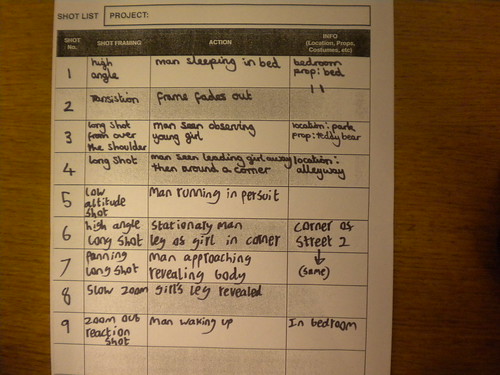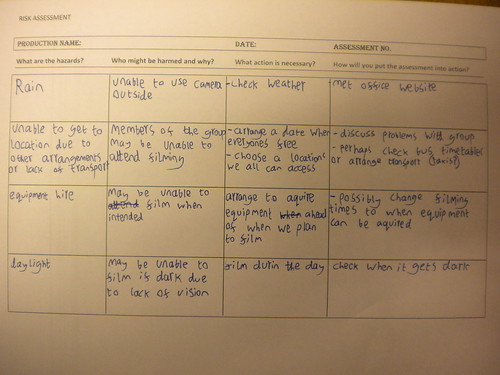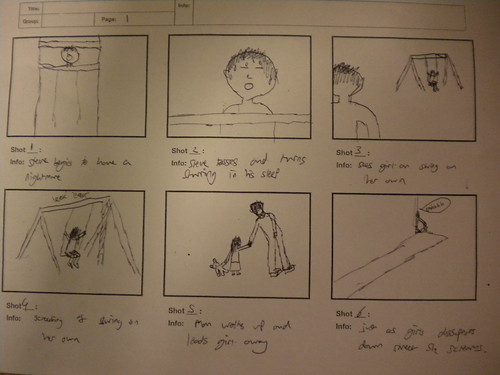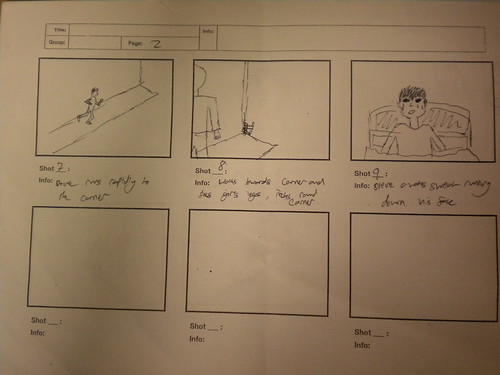Protagonist
The protagonist of a thriller sequence is the main character around whom the film revolves. Often seen as the 'hero', the protagonist often has some kind of problem to overcome or ends up in a situation from which he must get out. These problems, more often than not, and instigated by the antagonist.
The protagonist in our thriller was the main character who was having the nightmare. He follows the girl around his nightmare and whiteness the antagonist take her away, he then follows.
Antagonist
The antagonist is usually the 'arch enemy' of the protagonist. This is usually and most often another person but it can also be a group of people or something else, depending on the situation but in any case they will oppose the protagonist.
The antagonist in our project was the man in the dream who kidnaps the girl. He is the antagonist as he is taking the child from the main character and then he murders her, obviously having a negative effect on the main character.
Friday, 18 February 2011
Thursday, 17 February 2011
Tuesday, 15 February 2011
What we learnt from Amar
The Script
We learnt that a script was not purely dialogue and included basic instructional information about what to film, as well as how to film it. Consequently, were able to produce a script as well as an annotated version - also prompted by Amar.
Location Recce
We learnt about the importance of experience in the location, and through this we can gain a greater understanding of potential difficulties and risks.
Digital Storyboard
Through producing a Digital Story board, we gained a clearer picture and greater apprehension of our production.
Shot List
In creating a shot list, we gained increased organization at the time of shooting.
Shooting Schedule
Our shooting schedule enabled us to focus on the essential components, rather than spending excessive time on trivial matters.
We learnt that a script was not purely dialogue and included basic instructional information about what to film, as well as how to film it. Consequently, were able to produce a script as well as an annotated version - also prompted by Amar.
Location Recce
We learnt about the importance of experience in the location, and through this we can gain a greater understanding of potential difficulties and risks.
Digital Storyboard
Through producing a Digital Story board, we gained a clearer picture and greater apprehension of our production.
Shot List
In creating a shot list, we gained increased organization at the time of shooting.
Shooting Schedule
Our shooting schedule enabled us to focus on the essential components, rather than spending excessive time on trivial matters.
Friday, 4 February 2011
Mise on Scene
Costume
Young girl
- Bright coloured clothing to suggest purism,
- Simple clothes to suggest her social economic bracket.
- Hair in bunches, conforming to sterotype, portraying innocence.
Stranger
- Dark, mysterious clothing.
- Long black jacket, black boots and hunched posture to reflect his sinister personality.
Steve
- 'Normal' daytime clothes
- Smart-casual dress, suggesting a professional occupation.
Camera Work
Inside bedroom
-High angle shot to portray weakness.
Park
-Long shot for establishment.
-Extreme close-ups for disorientation - reflective of the dream environment.
Street
-Long shot for establishment of new location.
-Panning shot to enhance movement.
Young girl
- Bright coloured clothing to suggest purism,
- Simple clothes to suggest her social economic bracket.
- Hair in bunches, conforming to sterotype, portraying innocence.
Stranger
- Dark, mysterious clothing.
- Long black jacket, black boots and hunched posture to reflect his sinister personality.
Steve
- 'Normal' daytime clothes
- Smart-casual dress, suggesting a professional occupation.
Camera Work
Inside bedroom
-High angle shot to portray weakness.
Park
-Long shot for establishment.
-Extreme close-ups for disorientation - reflective of the dream environment.
Street
-Long shot for establishment of new location.
-Panning shot to enhance movement.
Location Recce
List of possible locations:
-Deal grove park
-Nearby street
-Mitchell's bedroom
Problem with these location:
- Other people could possibly end up in the shot, or could cause unwanted shadows.
- If it's raining we will be unable to film.
- There could possibly be traffic on the street which could interfere with sound and/or shooting.
- In Mitchell's room the lighting may be poor making it hard to film as visibility will be low. The same
problem applies for the other locations if we were to film at night so we are making sure to film during
the day.
- Ambient sound could interfere with our sound in all locations so shots may have to be shot repeatedly.
-Deal grove park
-Nearby street
-Mitchell's bedroom
Problem with these location:
- Other people could possibly end up in the shot, or could cause unwanted shadows.
- If it's raining we will be unable to film.
- There could possibly be traffic on the street which could interfere with sound and/or shooting.
- In Mitchell's room the lighting may be poor making it hard to film as visibility will be low. The same
problem applies for the other locations if we were to film at night so we are making sure to film during
the day.
- Ambient sound could interfere with our sound in all locations so shots may have to be shot repeatedly.
Why Thrillers Thrive
A 'thrill' can be defined as a emotional disturbance. The audience, in their nature enjoy, and to some extent, need these 'thrills' in order to reassure meaning and interest in their often mundane lifestyles.
'The cinema can leave the spectator with a subconscious assurance of absolute safety, and yet surprise his imagination into playing tricks on him.' The true power of successful cinema is to postpone reality and submerse the audience in its content - whether it be fictional or not.
The cinema is a more effective way of portraying 'thrills' than the theater due to the increased ease of one projecting oneself into their consciousness - the viewer is no longer a spectator, but a participant.
'The audience thrives of thrills, the cinema thrives on the audience, the director thrives on the cinema, and everybody is happy.' It is the consumer that creates the demand, and the industry is more than willing to supply if the market proves lucrative enough. The film industry producing films of a Thriller genre is no exception.
'The cinema can leave the spectator with a subconscious assurance of absolute safety, and yet surprise his imagination into playing tricks on him.' The true power of successful cinema is to postpone reality and submerse the audience in its content - whether it be fictional or not.
The cinema is a more effective way of portraying 'thrills' than the theater due to the increased ease of one projecting oneself into their consciousness - the viewer is no longer a spectator, but a participant.
'The audience thrives of thrills, the cinema thrives on the audience, the director thrives on the cinema, and everybody is happy.' It is the consumer that creates the demand, and the industry is more than willing to supply if the market proves lucrative enough. The film industry producing films of a Thriller genre is no exception.
Thursday, 3 February 2011
Thriller project shooting schedule
Friday Night:
4.10pm - Pick up equipment for weekend - Mitchell's House
7.00pm - Start filming: Frame 1, 9 - Mitchell's bedroom
Saturday:
12.00 - Rendezvous at Matt's house in Sawston
12.15 - Leave Matt's house and go to LOCATION 1 - The Park
12.25 - 1.25 - Film little girl in park (Shot 3)
record sound of squeaking swing
1.25 - Go to LOCATION 2 - alleyway/back streets
1.25 - 2.05 - LUNCH
2.05 3.05- Shoot down alleyway down road (Shots 3 4 5 6)
3.05 - Go to LOCATION 3 - Road
3.05 - 4.05 - Shoot road scene (Shots 7 8)
4.05 - 5.00 - rendezvous back at Matt's house for bacon sandwiches.
4.10pm - Pick up equipment for weekend - Mitchell's House
7.00pm - Start filming: Frame 1, 9 - Mitchell's bedroom
Saturday:
12.00 - Rendezvous at Matt's house in Sawston
12.15 - Leave Matt's house and go to LOCATION 1 - The Park
12.25 - 1.25 - Film little girl in park (Shot 3)
record sound of squeaking swing
1.25 - Go to LOCATION 2 - alleyway/back streets
1.25 - 2.05 - LUNCH
2.05 3.05- Shoot down alleyway down road (Shots 3 4 5 6)
3.05 - Go to LOCATION 3 - Road
3.05 - 4.05 - Shoot road scene (Shots 7 8)
4.05 - 5.00 - rendezvous back at Matt's house for bacon sandwiches.
Digital Storyboard
These are rough examples of our shots:
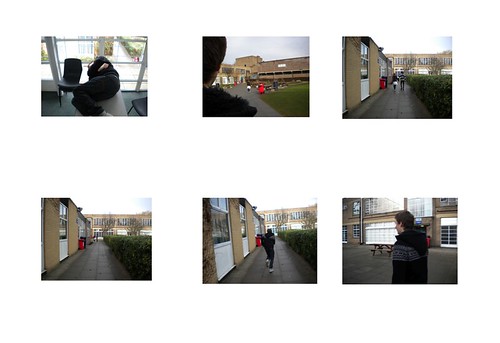
In the first shot we see the character sleeping about to enter a dream, in the actual piece he would be in a bed.
Next, there is an over the shoulder shot of the dreaming man watching the young girl on a swing, this will be set in a park.
Then, there are two consecutive shots of the girl being lead away by the stranger. This will be filmed along a street in the film.
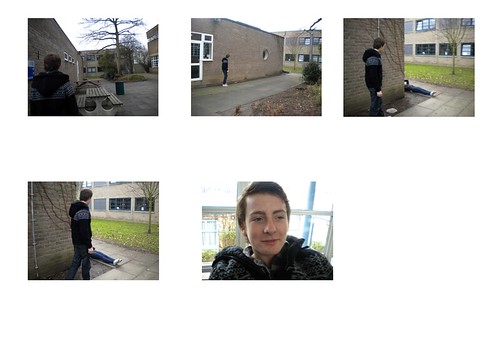
The dreaming man can then be seen in pursuit as he rapidly chases after them.
In the following shot, he pauses as he sees the leg of the young girl sticking out from around the courner.
After, the dreaming man slowly approaches and the next three frames convey his movement and a gradual zoom.
Finally have a reaction shot of the main character when he wakes up from the dream.

In the first shot we see the character sleeping about to enter a dream, in the actual piece he would be in a bed.
Next, there is an over the shoulder shot of the dreaming man watching the young girl on a swing, this will be set in a park.
Then, there are two consecutive shots of the girl being lead away by the stranger. This will be filmed along a street in the film.

The dreaming man can then be seen in pursuit as he rapidly chases after them.
In the following shot, he pauses as he sees the leg of the young girl sticking out from around the courner.
After, the dreaming man slowly approaches and the next three frames convey his movement and a gradual zoom.
Finally have a reaction shot of the main character when he wakes up from the dream.
Tuesday, 1 February 2011
Subscribe to:
Comments (Atom)

